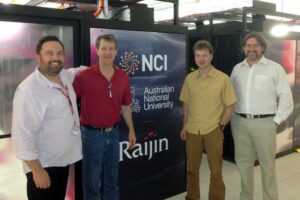A senior scientist at the USA’s National Centre of Atmospheric Research is using TERN to build international links in ecosystem data and modelling
A key component of TERN’s vision is to support not just national but also international networks of scientists, environmental managers and stakeholders. For Tim Hoar at the National Centre of Atmospheric Research (NCAR) in the USA it is these networks that are helping him reap collaborative rewards for his area of ecosystem science.
Collaboration and engagement is a large part of Tim’s job with NCAR, which provides research and education services in atmospheric and related sciences. It is operated by the University Corporation for Atmospheric Research under the sponsorship of the United States National Science Foundation.
Tim works closely with the Colorado-based National Ecological Observatory Network (NEON) – also one of TERN’s major partners – to provide national climate and atmospheric models for the USA.
Recently, Tim has been collaborating with Australia’s NEON equivalent, TERN, to provide similar modelling services to Australian researchers. Tim was keen to bring NCAR’s Data Assimilation Research Testbed (DART) to Australia after it was proved to be successful in the United States.
‘DART is a tool to help incorporate real observational data into climate and atmosphere models to make a them more accurately reflect the real-world situation,’ says Tim. ‘After working with NEON in the States, I knew that we would be able to work with TERN in Australia to achieve similar results.’
Tim and staff of TERN’s Ecosystem Modelling and Scaling Infrastructure (e-MAST), NEON and CSIRO were able to help set up DART and couple the system to Australia’s Community Atmosphere Biosphere Land Exchange (CABLE) model.
The systems, set up under e-MAST’s allocated space on the National Computation Infrastructure (NCI), are being used to deliver key continent-scale estimates of land-surface parameters including gross primary production, evapotranspiration, soil moisture, and stomatal conductance.
‘Having the opportunity to set up DART in Australia was fantastic. I’m confident that this collaborative project will enhance Australia’s ecosystem modelling infrastructure and researchers’ ability to produce new science. The whole process couldn’t have been achieved without the support of TERN’s infrastructure and network,’ says Tim.
  |  |  |
| Tim Hoar of USA’s National Centre of Atmospheric Research (NCAR) (above left with a lovely Chinook [king] salmon caught in an ‘unknown’ location) recently came to Australia with support from TERN and its partners to set up NCAR’s Data Assimilation Research Testbed (DART) – a tool that helps incorporate real observational data into climate and atmosphere models to make a them more accurately reflect the real-world situation. At right, the team responsible for installing and testing DART on the NCI supercomputer Raijin: (left to right) Dr Brad Evans (TERN’s e-MAST director, Macquarie University) , Tim Hoar (NCAR, USA), Dr Andy Fox (NEON, USA) and Dr Luigi Renzullo (CSIRO). | ||
Published in TERN newsletter July 2014






